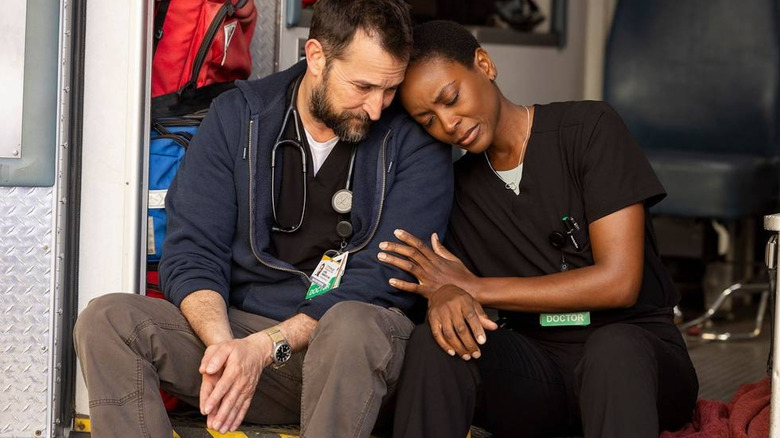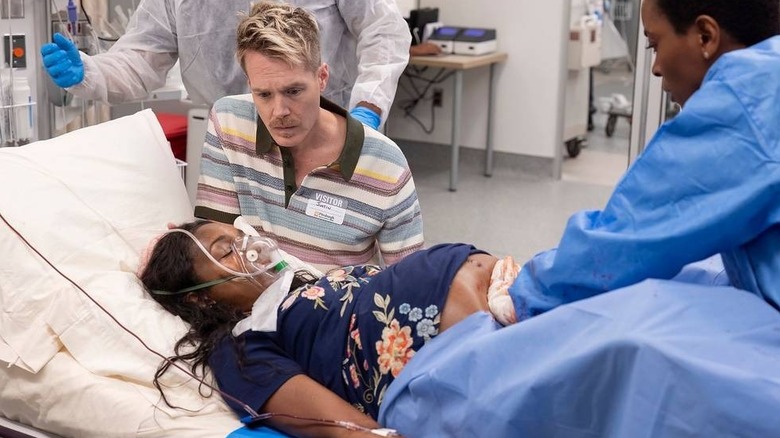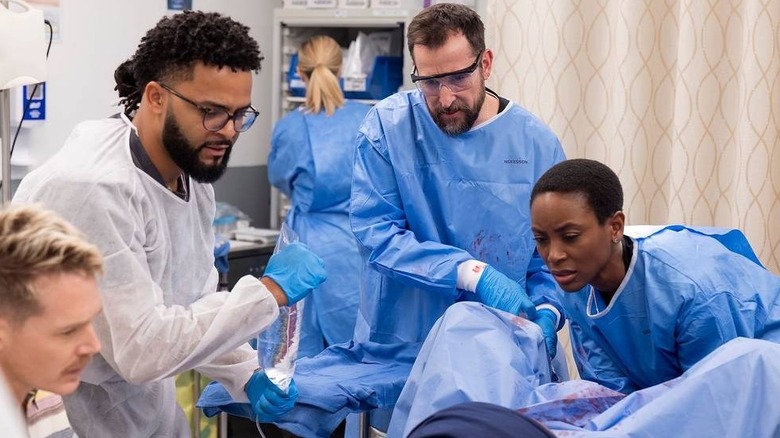Was The Birth Scene In The Pitt Real? The Graphic Moment, Explained
The hit HBO Max medical drama "The Pitt" has been praised for its incredible accuracy, and sometimes that includes realistic depictions of the blood and guts that make up a single shift in the emergency room. There are a whole lot of trauma wounds depicted on "The Pitt" because it takes place at the fictional Pittsburgh Trauma Medical Hospital, so things like broken bones and flesh wounds are the typical order of the day. However, one particular patient required a whole team of special effects artists to create. In season 1, episode 11, "5:00 P.M.," a complicated birth nearly kills both the mother and child, and "The Pitt" depicts the whole bloody ordeal in graphic detail. So, how the heck did the series do that without just using archival footage of a real birth?
According to a behind-the-scenes peek from Vulture, the show employed a special rig that had previously been used on the Prime Video "Dead Ringers" series to duplicate the lower half of actor Enuka Okuma's body, with the top part cut away so that she could sit underneath it and pop through, performing as the top half of her character Natalie. The rig featured a realistic birth canal, pregnant abdomen, and vagina, allowing the show's actors and hidden puppeteers to mimic someone giving birth with a silicone baby. It's seriously impressive special effects work that required a whole lot of people to make happen, but it was worth it to create one of season 1's most powerful scenes.
The Pitt's birth scene was created using prosthetics and puppets
In the episode, surrogate mother Natalie (Okuma) is having some problems while in labor, so Dr. Robby (Noah Wyle) and Dr. Collins (Tracy Ifeachor) must help her rotate her baby's shoulder so they can deliver them, then deal with serious bleeding afterward. There's always a lot going on in any scene on "The Pitt" because of the way the show is filmed, with multiple patients being "treated" on screen at any one time, but there were even more moving parts than usual here due to all the prosthetics and puppets. The rig itself was originally designed by Autonomous FX for the Showtime series "SMILF" before "Dead Ringers," and it was then painted to match Okuma's skin tone and had the prosthetic breasts removed so she could wear it more comfortably. (Autonomous FX also designed the incredible prosthetics that transformed Lily James and Sebastian Stan on Hulu's "Pam & Tommy," if that name sounds familiar.)
To film the scene, Okuma knelt underneath the belly and legs, putting her upper torso through the hole and making it look seamless, as if the prosthetics and her body were one. Wyle then reached into the prosthetic vagina and manipulated the silicone baby to help pull it out. The cast and crew then quickly switched it out for a puppet baby that could do subtle movements before pumping a tremendous amount of blood for the moment when Natalie begins hemorrhaging. According to Vulture, Okuma was assisted by an intimacy coordinator because the scene could leave her feeling pretty vulnerable despite the lower half on the gurney being a prosthetic. The overall goal, of course, was to make Okuma as comfortable as possible during this exhausting scene.
Being hands-on made it easer for The Pitt's actors to perform this scene
Because the show's actors were able to see and feel the prosthetic (and buckets of fake blood), it made performing this scene much easier and lended the whole thing an air of heightened realism and authenticity. As Wyle told Vulture:
"It allowed me to not have to simulate or imagine anything that I was doing. It's very rare in a medical show. Usually, you're not really doing the stuff you're doing. But this one, my hands were inside. The baby was in there. The baby's shoulder is caught on a pubic bone. I was trying to manipulate it and rotate it around so I could get this thing clear. Everything we did was possible because of the beautiful artistry behind the prosthetic."
While the scene feels (and looks) incredible accurate to the average viewer, some doctors were less impressed. In an interview with the Toronto Star, emergency physician Dr. Sahil Gupta said that they would have involved the obstetrician much more and that Dr. Robby wouldn't have been so central to treatment (but acknowledged this was for storytelling reasons). He also noted that the baby's shoulder being hooked was treated as much less scary than it would be in real life, but that overall, it was "kind of cool" to see everything represented as realistically as it was. As graphic as the birth was, it was vital as a part of the storytelling of "The Pitt." It will be interesting to see what patients and problems the show can come up with for season 2, and just how they end up being put on screen.
"The Pitt" is currently streaming on HBO Max.


